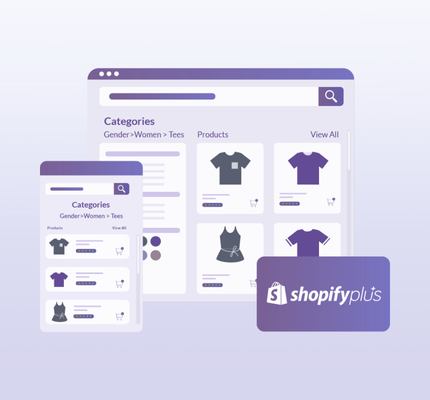Blog
Mind Games: The Psychology of Product Discovery in E-Commerce
As an online retailer, you’re always looking for ways to understand your customers better. A deeper knowledge of their motivations, habits, likes, and dislikes helps you provide better products, services, and overall experience. You need real commitment and a water-tight strategy when it comes to getting a clear understanding of your audience.
However much you interview, survey, and surmise — when it comes to truly insightful discovery, not much comes close to the power of cold, hard data. And if you’re looking to gain a better understanding of customer motivation, on-site search offers one of the richest resources out there.
By understanding why people choose to search, how they like to perform this task, and what puts them off, you can deliver a better user experience through optimized product discovery — leading to happier customers, fuller carts, and better sales.
This article will explore the various questions you can ask to better understand your customers, through the lens of on-site search. We’ll also suggest some practical ways you can apply this knowledge in your own store.
1. Hunt and Gather: What Causes People to Search?
Since the dawn of time, the human race has survived (and thrived) by exploiting the opportunity. In this respect, not much has changed since our mammoth-hunting days — we’re always looking for ways to secure or improve our situation.
As a result, the desire to search is hard-wired into our hunter-gatherer mindset.
So how does this translate into e-commerce? Online retail gives modern-day cavemen the ability to “hunt” around the clock — and we’re highly motivated to seek out the objects of our desires.
The dopamine hit shoppers experience from the discovery of the perfect product shouldn’t be underestimated. Online shopping feels good — there’s a reason “retail therapy” has become embedded in our lexicon.
Our brains acknowledge the reward of this positive neurotransmitter firing, and we feel compelled to repeat the process, chasing a replay of the same “purchasing pleasure” experience.
Search-Led vs Non-Search-Led User Journeys
So — we like to shop. But what can we learn from how customers approach this process? What are the differences between search-led and non-search-led customer journeys?
The standout factor here is intent. A search-led user journey is inherently purposeful and targeted. A tangible product is actively being sought. Revisiting our cavemen analogy, while your regular customers are sitting around the campfire, your search-led customers have sharpened their spears and are looking for tracks.
Capitalize on this knowledge to improve customer outcomes.
By paying attention to search-led customers’ psychological state (and how it differs from their non-searching counterparts) you can refine their experience and invest in improvements that will benefit the segment of your audience that’s disproportionately more likely to convert.
The Rising Sea of Searches
The way we interact with our digital environment is becoming ever more search-focused. From voice-search-powered home assistants like Alexa to the rise of the online marketplace — defaulting to search is becoming the norm.
Also, the huge catalogs of e-commerce giants like Amazon make search-led journeys essential. Yes, they’re masters of personalization and algorithm-fuelled product suggestions, but their customer journey is built around the all-important search bar. Customers know their chances of a successful search are high, so it becomes the instinctive starting point.
Search-led journeys convert at a rate 5-6 times higher than their non-search counterparts. Just 10% of total customers starting their shopping at the search bar can account for up to 40% of revenue.
Imagine providing a search experience so reliable and intelligent that it became the de facto choice for your customers…
2. What Can On-Site Search Tell Us About Customer Journey Mapping?
So, beyond boosting conversions and appealing to our inner hunter-gatherer, what else can on-site search do to assist our ecommerce success?
It’s a goldmine of truly unique customer insight. In fact, it’s hard to think of another data source that so reliably and accurately tells you exactly what your customers’ motivations are. And even better, they’re telling you in their own words.
Because of this, on-site search has a fantastic capacity to help retailers track customer intent. This has huge potential for helping brands get a better understanding of their market, via customer journey mapping.
By understanding how shoppers move through your store, the touch points they interact with as a result of their search, and the common pain points at which you see a higher bounce, you can really hone your offering.
Now You’re Speaking Their Language
When it comes to crafting customer journeys that convert, the process starts long before these happy shoppers reach your store. On-site search data gives you powerful insights into trending search terms and common phrasing being used for product discovery.
Leverage this knowledge within your content marketing, SEO, and paid advertising campaigns to speak a familiar language your customers will instantly understand.
Klevu gives you regular reports of trending search terms, but you have the opportunity to dive into the exploration of this data at any time via your Merchant Centre dashboard.
Pave Their Way With Personalized Promise
Exploring search-led intent can also help you to better optimize your store for product discovery.
By working with Klevu’s intelligent, AI-powered on-site search solution you can harness the collective power of your customers’ search patterns to fully automate your merchandising across results pages (or even your category pages, if you’re looking for top-level impact).
Interaction with search offers a powerful opportunity for influence via product discovery, and when working with Klevu, this can be further enhanced and optimized. Quick search overlay can offer product discovery before a single keystroke.
When combined with powerful personalization to further refine suggestions and product ordering, your store is primed for fully optimized product discovery.
The result? Whatever your customers are searching for, the chances are you’ll be showing them what they want before they even know they want it.
3. What Causes People to Abandon a Search?
Search can be a powerful ally to conversion, but it can also give you some insight into why your customers might be failing to follow through to purchase.
When we know that shoppers are displaying a high motivation to make a purchase, it’s important to establish what changed their minds and turned them away from the checkout button.
The metric to track here is search abandonment. For a deep dive, check out our free guide to on-site search KPIs. In it, you’ll learn exactly how to track, measure, and improve your outcomes when it comes to helping your customers find exactly what they’re looking for.
There are many reasons why a customer could be turned off by the search process on your site. As the use of search becomes more ubiquitous, expectations for the user experience are rising. If you’re not offering a quick and functional pathway to the items they have in mind customers may well bounce.
Banish the Bounce Rate
There are practical steps you can take to keep customers happy enough to stay on the path to search-led conversion. Klevu integrates easily with Google Analytics, and you can use the two tools in combination to examine your abandonment rate after interaction with a search.
Then it’s time to ask yourself some hard questions. Does the quality of your search solution’s functionality mean that shoppers aren’t finding what they are looking for? Or is it an experience issue? Are the options for refining their search results too off-putting, and overwhelming?
Thankfully, a solution like Klevu can help to bring swift improvements to both functionality and user experience.
By ensuring a better comprehension of search terms (thanks to an automatically enriched catalog of search terms and the next-level intelligence of natural language processing) Klevu can dramatically decrease the risk of your customers not finding what they were hoping for.
And by leveraging dynamic filters, you can ensure that search results pages are sleek and optimized for quick product discovery, with only filters relating to the displayed products being displayed. In combination, both of these features will have a noticeable impact on your abandoned search rate.
With purchase intent so high, customers who interact with search should be easy sales. It’s so important to put yourself in your customers’ position to find and fix barriers to conversion here.
Don’t lose out because of a frustrating or fruitless search.
4. What’s the Impact of Conversational Commerce on Search?
The way we interact with technology is evolving all the time. As well as becoming more dependent on the search-led discovery, we’re also becoming increasingly chatty.
Conversational interaction with search engines is skyrocketing. 39.3% of Millennials used voice-enabled assistants at least once a month in 2019. And it’s estimated that there are 21.4 million smart speakers in the US right now.
The presumed reasons behind this are varied. On one hand, our familiarity with voice search and cultural exposure to its use is increasing. This reduces barriers to use and encourages more experimentation.
A big hike in the amount of ecommerce performed on mobile devices (53% of sales happen via mobile) could also be a factor — small screens, a reluctance to type on the go and the growing expectation of accurate interpretation of our voice command all combine to boost the appeal of voice search on mobile devices.
Conversation Pieces
Thanks to the personification of the devices we commonly interact with (Alexa, Siri) our interaction naturally defaults to a more conversational tone.
What does this mean for your on-site search experience? Your customers will be highly likely to want to interact in a more conversational manner. This might mean voice searches phrased as “Show me dresses for a Christmas party” instead of “gold glitter midi dress.” Your customer base will increasingly expect intelligent interpretation of these kinds of search terms.
How can you make sure your site is ready for and responsive to this more colloquial language?
By working with a partner that understands and invests in the power of conversational commerce. Klevu leverages advanced NLP and enables accurate, efficient voice search so your talkative customers get exactly what they’re asking for.
Into Their Heads and Ahead of the Game
When looking to optimize the performance and appeal of your online store, understanding your customers is mission-critical.
By getting a better understanding of the motivations, triggers, prompts, and blockers that accompany interaction with search, you can raise your game and your conversion rate.
Book a demo today to learn how Klevu’s sophisticated on-site search solution can help you discover and deliver exactly what your customers want.


